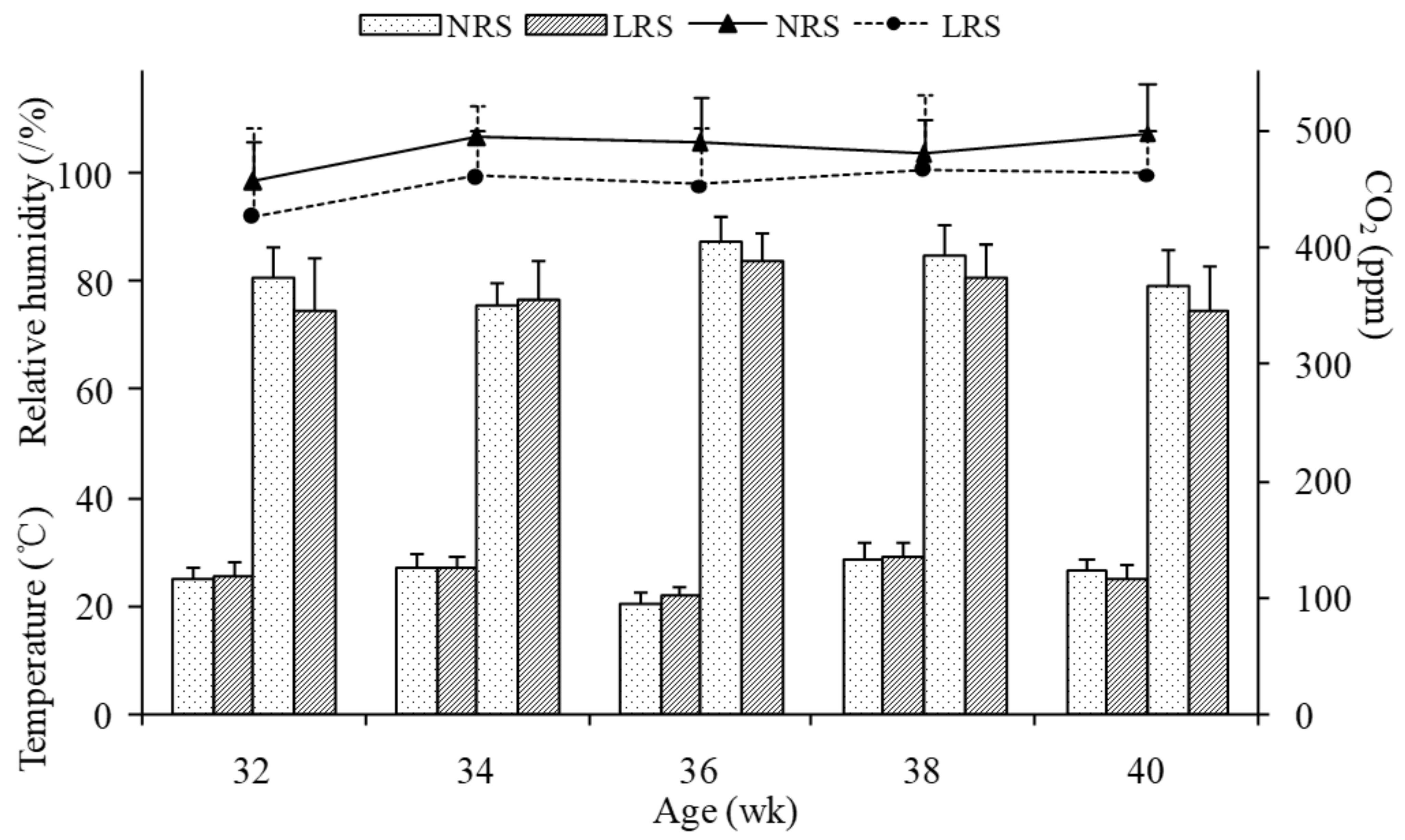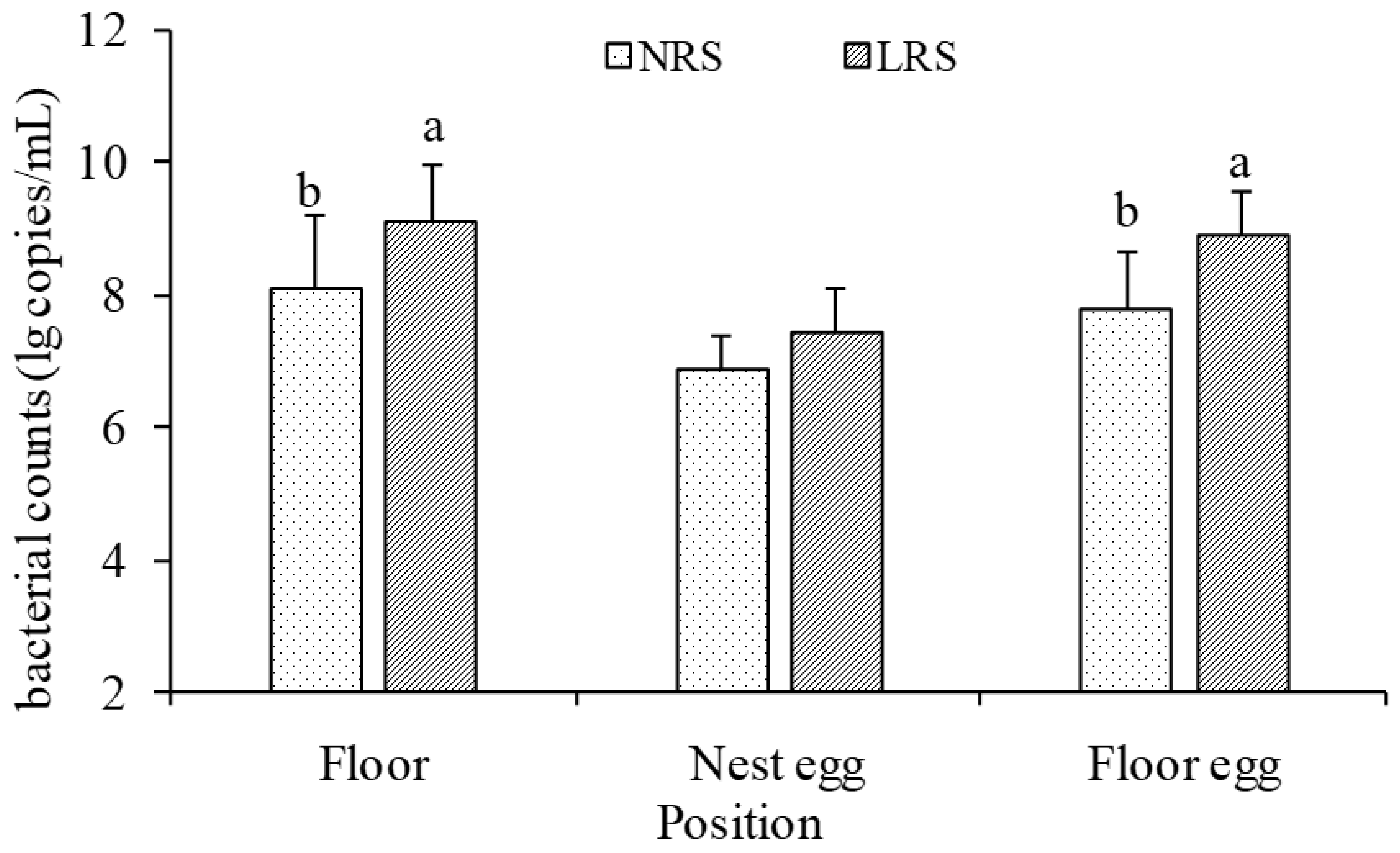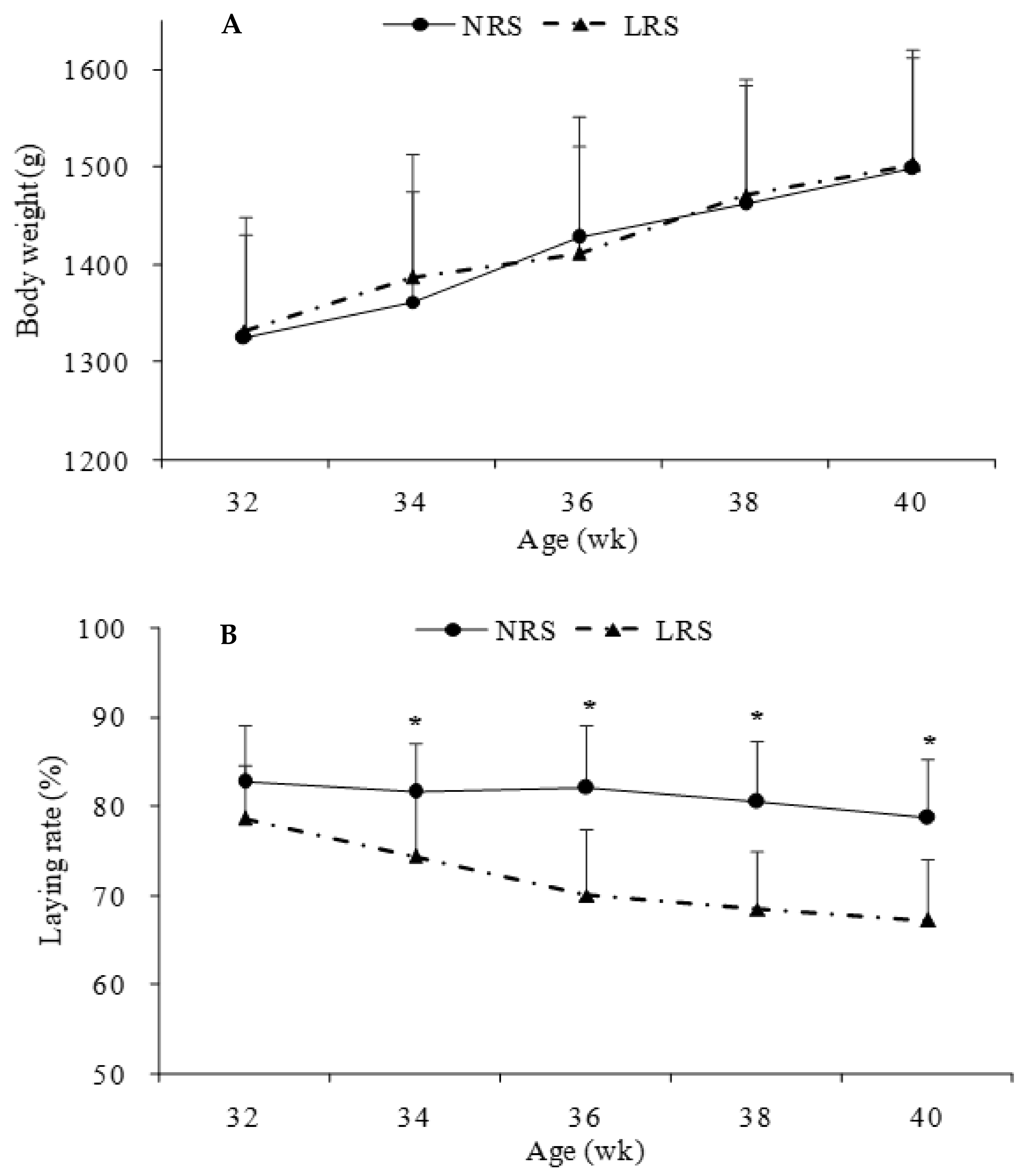Effects of Different Non-Cage Housing Systems on the Production Performance, Serum Parameters and Intestinal Morphology of Laying Hens
Abstract
Simple Summary
Abstract
1. Introduction
2. Materials and Methods
2.1. Animals and Management
2.2. Measurement of Indoor Airborne Parameters
2.3. Measurement of Indoor Ground Contamination
2.3.1. Sample Collection
2.3.2. DNA Extraction and PCR Amplification of 16S rRNA Sequences
2.3.3. Preparation of the Plasmid Standard
2.3.4. qRT-PCR
2.4. Production Performance
2.5. Measurements of Serum Biochemical Parameters
2.6. Measurements of Intestinal Morphology
2.7. Statistical Analysis
3. Results
3.1. Indoor Airborne Parameters
3.2. Indoor Ground Contamination
3.3. Production Performance
3.4. Serum Parameters
3.5. Intestinal Morphology
4. Discussion
5. Conclusions
Author Contributions
Funding
Institutional Review Board Statement
Data Availability Statement
Acknowledgments
Conflicts of Interest
References
- Fu, D.Z.; Zhang, D.X.; Xu, G.Y.; Li, K.Y.; Wang, Q.; Zhang, Z.B.; Li, J.Y.; Chen, Y.; Jia, Y.X.; Qu, L.J. Effects of different rearing systems on meat production traits and meat fiber microstructure of Beijing-you chicken. Anim. Sci. J. 2015, 7, 729–735. [Google Scholar] [CrossRef]
- Ferrante, V.; Susanna, L.; Giuseppe, V.; Cavalchini, L.G. Effects of two different rearing systems (organic and barn) on production performance, animal welfare traits and egg quality characteristics in laying hens. Ital. J. Anim. Sci. 2009, 8, 165–174. [Google Scholar] [CrossRef]
- Tauson, R. Management and housing systems for layers—Effects on welfare and production. World Poult. Sci. J. 2005, 61, 477–490. [Google Scholar] [CrossRef]
- Zofia, S.; Magdalena, D.; Jadwiga, T.; Józefa, K.; Anna, A. The effect of the type of non-caged housing system, genotype and age on the behaviour of laying hens. Animals 2020, 10, 2450. [Google Scholar]
- Almeida, E.A.; Arantes de Souza, L.F.; Sant, A.C.; Bahiense, R.N.; Macari, M.; Furlan, R.L. Poultry rearing on perforated plastic floors and the effect on air quality, growth performance, and carcass injuries—Experiment 1: Thermal comfort. Poult. Sci. 2017, 96, 3155–3162. [Google Scholar] [CrossRef] [PubMed]
- Zhang, C.; Richard, H.; Chen, K.K.; Zhao, X.H.; Yang, L.; Wang, L.; Chen, X.Y.; Jin, S.H.; Geng, Z.Y. Effects of different rearing systems on growth performance, carcass traits, meat quality and serum biochemical parameters of Chaohu ducks. Anim. Sci. J. 2018, 4, 672–678. [Google Scholar] [CrossRef]
- Li, J.H.; Miao, Z.Q.; Tian, W.X.; Yang, Y.; Wang, J.D.; Yang, Y. Effects of different rearing systems on growth, small intestinal morphology and selected indices of fermentation status in broilers. Anim. Sci. J. 2016, 88, 900–908. [Google Scholar] [CrossRef]
- Wang, Y.; Ru, Y.J.; Liu, J.H.; Chang, W.H.; Zhang, S.; Yan, H.J.; Zheng, A.J.; Lou, R.Y.; Liu, Z.Y.; Cai, H.Y. Effects of different rearing systems on growth performance, nutrients digestibility, digestive organ weight, carcass traits, and energy utilization in male broiler chickens. Livest. Sci. 2015, 176, 135–140. [Google Scholar] [CrossRef]
- Mariam, E.A.; Afaf, Y.A.; Faten, K.A.; Gehan, R.; Magdy, M.M. Production performance of different broiler breeds under different housing systems. Int. J. Poult. Sci. 2012, 11, 190–195. [Google Scholar]
- Heerkens, J.L.T.; Delezie, E.; Kempen, I.; Zoons, J.; Ampe, B.; Rodenburg, T.B.; Tuyttens, F.A.M. Specific characteristics of the aviary housing system affect plumage condition, mortality and production in laying hens. Poult. Sci. 2015, 94, 2008–2017. [Google Scholar] [CrossRef]
- Calvet, S.; Estellés, F.; Cambra-López, M.; Torres, A.G.; Van den Weghe, H.F.A. The influence of broiler activity, growth rate, and litter on carbon dioxide balances for the determination of ventilation flow rates in broiler production. Poult. Sci. 2011, 90, 2449–2458. [Google Scholar] [CrossRef] [PubMed]
- Cambra-López, M.; Aarnink, A.; Zhao, Y.; Calvet, S.; Torres, A. Airborne particulate matter from livestock production systems: A review of an air pollution problem. Environ. Pollut. 2009, 158, 1–17. [Google Scholar] [CrossRef]
- Madelin, T.M.; Wathes, C.M. Air hygiene in a broiler house: Comparison of deep litter with raised netting floors. Brit. Poult. Sci. 1989, 30, 23–37. [Google Scholar] [CrossRef] [PubMed]
- Woodward, C.L.; Park, S.Y.; Jackson, D.R.; Li, X.; Birkhold, S.G.; Pillal, S.D.; Ricke, S.C. Optimization and comparison of bacterial load and sampling time for bioaerosol detection systems in a poultry layer house. J. Appl. Poult. Res. 2004, 13, 433–442. [Google Scholar] [CrossRef]
- Akpobome, G.O.; Fanguy, R.C. Evaluation of cage floor systems for production of commercial broilers. Poult. Sci. 1992, 71, 274–280. [Google Scholar] [CrossRef] [PubMed]
- Englmaierová, M.; Tumová, E.; Charvátová, V.; Skřivan, M. Effects of laying hens housing system on laying performance, egg quality characteristics, and egg microbial contamination. Czech J. Anim. Sci. 2014, 59, 345–352. [Google Scholar] [CrossRef]
- Shimmura, T.; Hirahara, S.; Azuma, T.; Suzuki, T.; Eguchi, Y.; Uetake, K.; Tanaka, T. Multi-factorial investigation of various housing systems for laying hens. Br. Poult. Sci. 2010, 51, 31–42. [Google Scholar] [CrossRef]
- Jin, S.H.; Fan, X.F.; Yang, L.; He, T.T.; Xu, Y.; Chen, X.Y.; Liu, P.; Geng, Z.Y. Effects of rearing systems on growth performance, carcass yield, meat quality, lymphoid organ indices, and serum biochemistry of Wannan Yellow chickens. Anim. Sci. J. 2019, 90, 887–893. [Google Scholar] [CrossRef]
- Sun, L.; Wang, Y.; Xie, H. Effects of feeding modes and low nutrient levels on growth performance and serum biochemical indexes of meat geese aged from 5 to 8 weeks. Chin. J. Anim. Nutr. 2015, 27, 740–748. [Google Scholar]
- Apple, F.S. Presence of creatine kinase mb isoenzyme during marathon training. N. Engl. J. Med. 1981, 305, 764–765. [Google Scholar] [PubMed]
- Oscai, L.; Patterson, J.; Bogard, D.; Beck, R.; Rothermel, B. Normalization of serum triglyceride and lipoprotein electrophoretic patterns by exercise. Am. J. Cardiol. 1972, 30, 775–780. [Google Scholar] [CrossRef]
- Schulz, J.B.; Lindenau, J.; Seyfried, J.; Dichgans, J. Glutathione, oxidative stress and neurodegeneration. Eur. J. Biochem. 2000, 267, 4904–4911. [Google Scholar] [CrossRef] [PubMed]
- Wu, B.; Cui, H.; Xi, P.; Jing, F.; Huang, J. Investigation of the serum oxidative stress in broilers fed on diets supplemented with nickel chloride. Health 2013, 5, 454–459. [Google Scholar] [CrossRef]
- Olanrewaju, H.A.; Wongpichet, S.; Thaxton, J.P.; Dozier, W.A.; Branton, S.L. Stress and acid-base balance in chickens. Poult. Sci. 2006, 85, 1266–1274. [Google Scholar] [CrossRef]
- Camp, J.; Kanther, M.; Semova, I.; Rawls, J. Patterns and scales in gastrointestinal microbial ecology. Gastroenterology 2009, 136, 1989–2002. [Google Scholar] [CrossRef] [PubMed]
- Ruangpanit, Y.; Matsushita, K.; Mukai, K.; Kikusato, M. Effect of trehalose supplementation on growth performance and intestinal morphology in broiler chickens. Vet. Anim. Sci. 2020, 10, 100142. [Google Scholar] [CrossRef] [PubMed]




| Housing System 1 | Body Weight, g | Laying Rate, % | Mortality, % | Egg Weight, g | Eggshell Strength, kg/cm2 | Haugh Unit |
|---|---|---|---|---|---|---|
| NRS | 1415.04 ± 143.84 | 81.69 ± 8.44 a | 0.04 ± 0.01 | 46.90 ± 1.46 | 4.43 ± 1.01 | 78.70 ± 9.01 |
| LRS | 1420.76 ± 132.37 | 71.74 ± 8.81 b | 0.03 ± 0.01 | 46.15 ± 1.58 | 4.08 ± 1.13 | 80.07 ± 9.46 |
| Housing System 1 | T-CH, mmol/L | TG, mmol/L | MDA, ng/mL | CORT, ng/mL | GSH-Px, ng/mL | SOD, ng/mL | CK, ng/mL |
|---|---|---|---|---|---|---|---|
| NRS | 4.01 ± 0.62 | 5.48 ± 0.70 | 48.02 ± 3.22 b | 106.73 ± 10.36 | 24.84 ± 3.95 a | 48.25 ± 6.25 a | 272.81 ± 21.50 |
| LRS | 4.19 ± 0.56 | 6.03 ± 0.77 | 54.28 ± 4.31 a | 113.45 ± 11.39 | 16.72 ± 2.81 b | 35.73 ± 5.07 b | 259.60 ± 25.39 |
| Intestinal Parts | Item 1 | Housing System 2 | |
|---|---|---|---|
| NRS | LRS | ||
| Duodenum | VH | 1203.82 ± 157.49 a | 955.45 ± 164.07 b |
| CD | 129.13 ± 14.92 | 111.61 ± 18.18 | |
| VCR | 9.29 ± 1.85 | 8.55 ± 1.63 | |
| Jejunum | VH | 1016.03 ± 148.67 a | 796.52 ± 122.01 b |
| CD | 96.94 ± 10.21 | 97.03 ± 10.89 | |
| VCR | 11.05 ± 1.14 a | 8.61 ± 1.55 b | |
| Ileum | VH | 618.88 ± 34.53 a | 360.35 ± 21.60 b |
| CD | 102.03 ± 9.32 | 104.15 ± 9.15 | |
| VCR | 6.02 ± 0.93 a | 3.71 ± 0.52 b | |
| Caecum | VH | 605.80 ± 41.10 | 572.49 ± 31.90 |
| CD | 101.83 ± 12.57 | 124.51 ± 13.04 | |
| VCR | 5.95 ± 0.79 a | 4.57 ± 0.67 b | |
Publisher’s Note: MDPI stays neutral with regard to jurisdictional claims in published maps and institutional affiliations. |
© 2021 by the authors. Licensee MDPI, Basel, Switzerland. This article is an open access article distributed under the terms and conditions of the Creative Commons Attribution (CC BY) license (https://creativecommons.org/licenses/by/4.0/).
Share and Cite
Wan, Y.; Yang, H.; Zhang, H.; Ma, R.; Qi, R.; Li, J.; Liu, W.; Li, Y.; Zhan, K. Effects of Different Non-Cage Housing Systems on the Production Performance, Serum Parameters and Intestinal Morphology of Laying Hens. Animals 2021, 11, 1673. https://doi.org/10.3390/ani11061673
Wan Y, Yang H, Zhang H, Ma R, Qi R, Li J, Liu W, Li Y, Zhan K. Effects of Different Non-Cage Housing Systems on the Production Performance, Serum Parameters and Intestinal Morphology of Laying Hens. Animals. 2021; 11(6):1673. https://doi.org/10.3390/ani11061673
Chicago/Turabian StyleWan, Yi, Huan Yang, Hongyi Zhang, Ruiyu Ma, Renrong Qi, Junying Li, Wei Liu, Yan Li, and Kai Zhan. 2021. "Effects of Different Non-Cage Housing Systems on the Production Performance, Serum Parameters and Intestinal Morphology of Laying Hens" Animals 11, no. 6: 1673. https://doi.org/10.3390/ani11061673
APA StyleWan, Y., Yang, H., Zhang, H., Ma, R., Qi, R., Li, J., Liu, W., Li, Y., & Zhan, K. (2021). Effects of Different Non-Cage Housing Systems on the Production Performance, Serum Parameters and Intestinal Morphology of Laying Hens. Animals, 11(6), 1673. https://doi.org/10.3390/ani11061673







